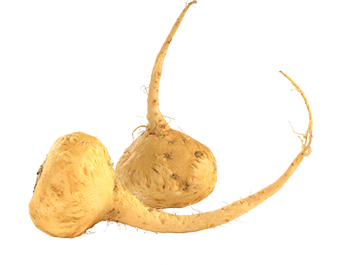

Maca (Lepidium meyenii Walp), sometimes referred to as Peruvian ginseng because of its similar properties, is a cruciferous plant whose root resembles the parsnip, radish and turnip. For over 2,000 years it has been cultivated as a vegetable crop by the people of Peru, where it grows in the barren high plateaus of the central Andes, thriving in the harsh conditions.
Dried Maca is rich in complex carbohydrates, including polysaccharides and both soluble and insoluble fiber. It contains linoleic, palmitic and oleic acids as well as several secondary metabolites which are only found in the maca plant; macaridine, macaene, macamides and maca alkaloids. Glucosinolates are also secondary plant metabolites present in maca, which when broken down produce a variety of bioactive compounds, including isothiocyanates and indole products like indole-3-carbinol. Other compounds in maca include flavonoids, quercetin, saponins, tannins and sterols like beta-sitosterol, campesterol, ergosterol, brassicasterol, ergostadienol and stigmasterol. Maca is also a good source of amino acids, iron, magnesium, calcium and potassium.*


| Product | Specifications | Extraction/Drying Method | Applications |
|---|---|---|---|
Maca Root Powder (organic)
 | Country of Origin: Peru Part used: Root Appearance: Beige to light brown powder Solubility: Partly soluble Certifications: Organic, Kosher and Food grade Produced in a BRC certified facility | Dehydrated | Dietary supplements Functional foods Functional beverages Pet foods |
MacaXtra® (organic)
 | Assay: > 0.8% Glucosinolate Country of Origin: Peru Part used: Root Appearance: Beige to light brown powder Solubility: Partly soluble Certifications: Organic, Kosher and Food grade Produced in a BRC certified facility | Dehydrated | Dietary supplements Functional foods Functional beverages Pet foods |